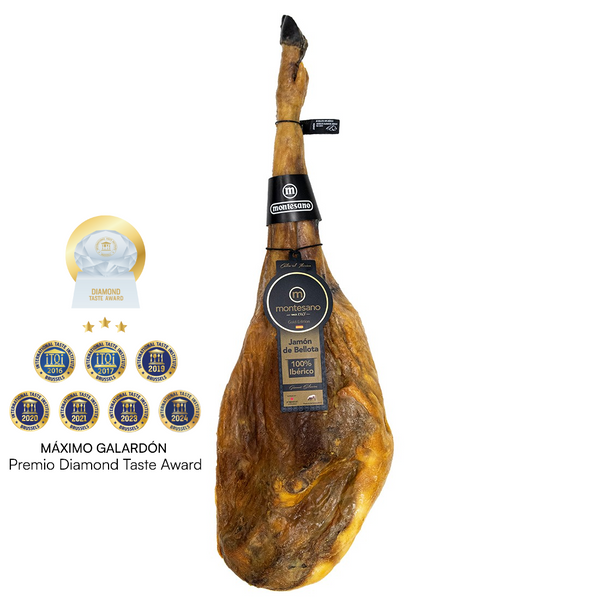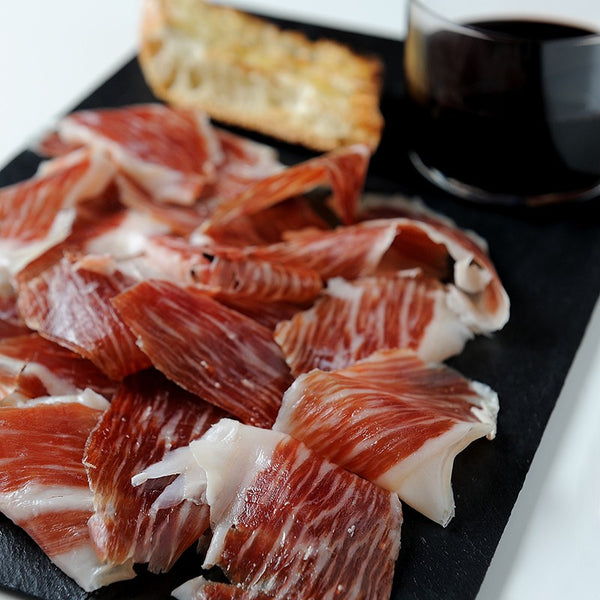Award-Winning Jamón de Bellota 100% Ibérico Black label 7-8Kg
100% Iberian acorn-fed ham, a ham that has achieved the highest global gastronomic award, the Diamond Award, from the prestigious International Taste Institute of Brussels 2024
 The Ibérico pig is native and exclusive to the Iberian Peninsula and raised freely in a unique ecosystem known as the Dehesa. These are extensive Mediterranean woodlands abundant in Cork and Holm oak trees whose fruit, the acorn (“bellota”), along with the fresh aromatic grass is the staple diet of the Ibérico pig. Also known as “Pata Negra”, it is the most revered ham in Spain.
The Ibérico pig is native and exclusive to the Iberian Peninsula and raised freely in a unique ecosystem known as the Dehesa. These are extensive Mediterranean woodlands abundant in Cork and Holm oak trees whose fruit, the acorn (“bellota”), along with the fresh aromatic grass is the staple diet of the Ibérico pig. Also known as “Pata Negra”, it is the most revered ham in Spain.
'De Bellota' - Free-range Acorn-fed
50% / 75% - Ibérico cross-bred with Duroc or Landrace (Red Label)
Cebo Campo - Free-range fed on acorns and cereal/grain
Cebo - intensively farmed and Cereal/ Grain-fed (Green label)
Bellota Ibérico Ham storage and cutting suggestion
On arrival
We recommend storing your Bellota ham in a dry, cool and preferably dark area covered in a cloth or towel for protection either hanging from the rope or in its stand (jamonero). You can keep it like this for several months.
Ibérico Ham appearance:
You may notice small white spots or chalky granules on the surface of your Ibérico ham – these occur naturally in the curing and maturation process. In fact they are an indication of a properly aged ham and form during the curing process. They are amino acids found in aged meat and cheese products and are perfectly safe to eat.
Salt:
Sometimes salt may form on the surface of your Ibérico ham in dry conditions. This does not affect the flavour of jamón Ibérico and can be brushed or wiped away.
Fat:
Whole Ibérico hams tend to be rather fatty, which protects the meat and helps it keep longer.
Remember the old saying; "Fat is flavour."
To slice:
Firstly place your Ibérico ham in the stand (jamonero) most commonly with the hoof up to start.Now make a deep cut in to the cana (shank) and then remove the layer of fat from the top and the sides until the meat is exposed, If you plan to consume the entire ham in a day or two, you can remove the skin and fat completely. If not, it is better only to remove the skin and outer fat layer from the area to be sliced that day.
Using the correct long bladed ham knife cut small, very thin slices, including some of the marbled fat making sure the cutting surface is kept horizontal. Slice downwards with your free hand behind the knife to avoid accidents.
Ibérico Ham should be consumed at room temperature when it will have a lustrous appearance. When too cold, the fat will appear opaque. To enjoy Ibérico ham at it’s best it should be consumed immediately, or covered in plastic wrap, to avoid prolonged exposure of the ham to air. In addition, each time you slice the ham, you should protect the cut area with butcher paper, a cloth moistened with olive oil, or with a bit of the trimmed skin and fat layer, so that the cut area remains fresh. To further protect the ham, you may cover it with a clean tea towel.




